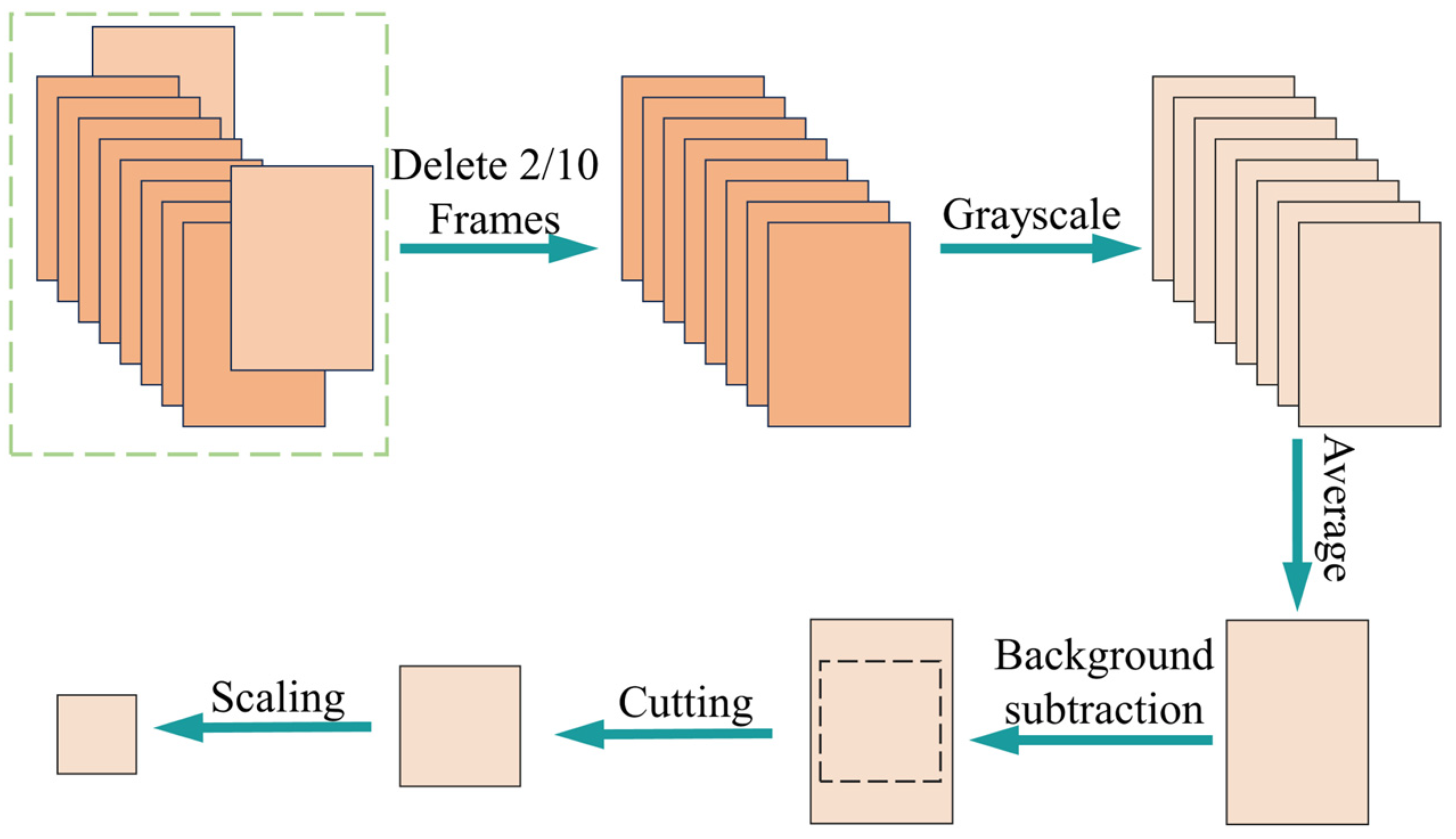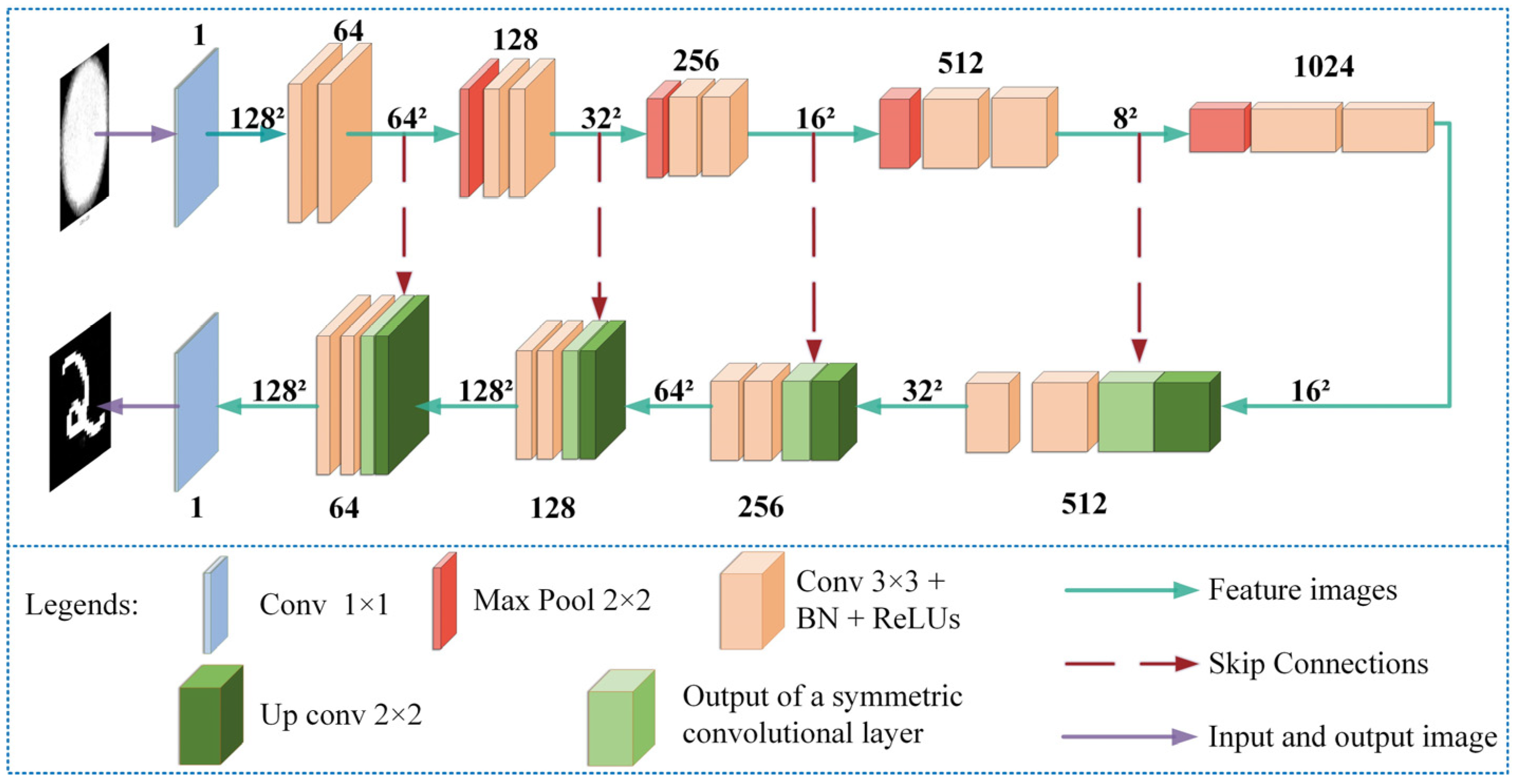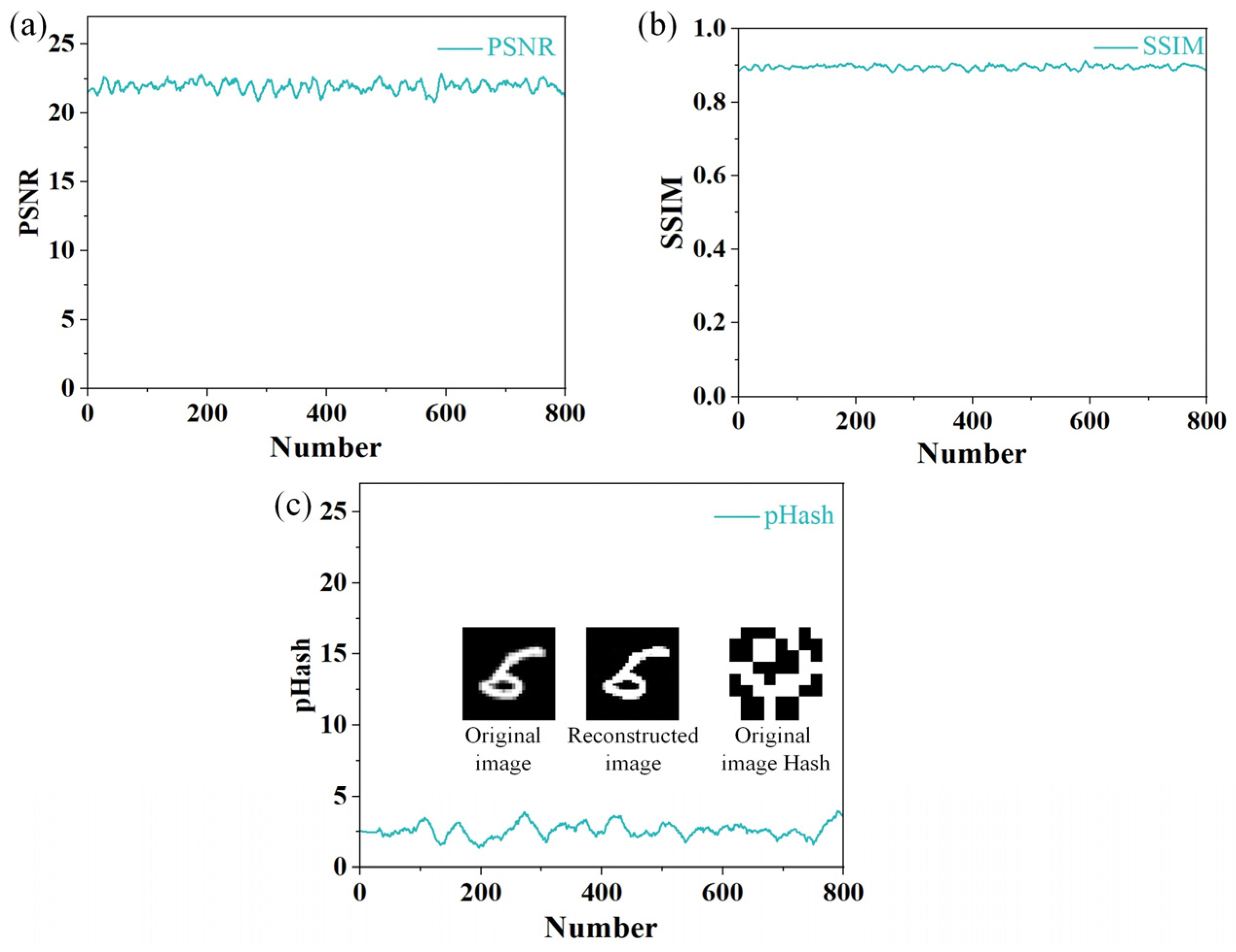Image Reconstruction Through Multimode Polymer Optical Fiber for Potential Optical Recording of Neural Activity
Abstract
1. Introduction
2. Principle
3. Methods
3.1. Experimental Setup
3.2. Image Process
3.3. Network Structure
4. Results and Analysis
4.1. Qualitative Analysis
4.2. PSNR Analysis
4.3. SSIM Analysis
4.4. Comparison of pHash Algorithm
5. Conclusions
Author Contributions
Funding
Institutional Review Board Statement
Informed Consent Statement
Data Availability Statement
Acknowledgments
Conflicts of Interest
References
- Yang, J.; Sui, S.F.; Liu, Z. Brain structure and structural basis of neurodegenerative diseases. Biophys. Rep. 2022, 8, 170–181. [Google Scholar] [CrossRef] [PubMed]
- Fan, J.; Fang, L.; Wu, J.; Guo, Y.; Dai, Q. From Brain Science to Artificial Intelligence. Engineering 2020, 6, 248–252. [Google Scholar] [CrossRef]
- Vázquez-Guardado, A.; Yang, Y.; Bandodkar, A.J.; Rogers, J.A. Recent advances in neurotechnologies with broad potential for neuroscience research. Nat. Neurosci. 2020, 23, 1522–1536. [Google Scholar] [CrossRef] [PubMed]
- Rivnay, J.; Wang, H.; Fenno, L.; Deisseroth, K.; Malliaras, G.G. Next-generation probes, particles, and proteins for neural interfacing. Sci. Adv. 2017, 3, e1601649. [Google Scholar] [CrossRef]
- Kwon, Y.W.; Jun, Y.S.; Park, Y.-G.; Jang, J.; Park, J.-U. Recent advances in electronic devices for monitoring and modulation of brain. Nano Res. 2021, 14, 3070–3095. [Google Scholar] [CrossRef]
- Akemann, W.; Wolf, S.; Villette, V.; Mathieu, B.; Tangara, A.; Fodor, J.; Ventalon, C.; Léger, J.-F.; Dieudonné, S.; Bourdieu, L. Fast optical recording of neuronal activity by three-dimensional custom-access serial holography. Nat. Methods 2022, 19, 100–110. [Google Scholar] [CrossRef]
- Ji, N.; Freeman, J.; Smith, S.L. Technologies for imaging neural activity in large volumes. Nat. Neurosci. 2016, 19, 1154–1164. [Google Scholar] [CrossRef]
- Barson, D.; Hamodi, A.S.; Shen, X.; Lur, G.; Constable, R.T.; Cardin, J.A.; Crair, M.C.; Higley, M.J. Simultaneous mesoscopic and two-photon imaging of neuronal activity in cortical circuits. Nat. Methods 2020, 17, 107–113. [Google Scholar] [CrossRef]
- Saito, A.; Takahashi, M.; Jimbo, Y.; Nakasono, S. Non-conductive and miniature fiber-optic imaging system for real-time detection of neuronal activity in time-varying electromagnetic fields. Biosens. Bioelectron. 2017, 87, 786–793. [Google Scholar] [CrossRef]
- Chen, S.; Wang, Z.; Xiao, K.; He, B.; Zhao, J.; Yang, X.; Liu, Q.; Sharma, A.K.; Leal Junior, A.; Min, R. A comprehensive review of optical fiber technologies in optogenetics and their prospective developments in future clinical therapies. Opt. Laser Technol. 2024, 179, 111332. [Google Scholar] [CrossRef]
- Kuang, R.; Wang, Z.; Ma, L.; Wang, H.; Chen, Q.; Junior, A.L.; Kumar, S.; Li, X.; Marques, C.; Min, R. Smart photonic wristband for pulse wave monitoring. Opto-Electron. Sci. 2024, 3, 240009. [Google Scholar] [CrossRef]
- Abdulaziz, A.; Mekhail, S.P.; Altmann, Y.; Padgett, M.J.; McLaughlin, S. Robust real-time imaging through flexible multimode fibers. Sci. Rep. 2023, 13, 11371. [Google Scholar] [CrossRef]
- Gao, Z.; Jiang, T.; Zhang, M.; Wu, H.; Tang, M. Optical semantic communication through multimode fiber: From symbol transmission to sentiment analysis. Light Sci. Appl. 2025, 14, 60. [Google Scholar] [CrossRef] [PubMed]
- He, G. Optical phase conjugation: Principles, techniques, and applications. Prog. Quantum Electron. 2002, 26, 131–191. [Google Scholar] [CrossRef]
- Vellekoop, I.M.; Mosk, A.P. Focusing coherent light through opaque strongly scattering media. Opt. Lett. 2007, 32, 2309. [Google Scholar] [CrossRef]
- Mosk, A.P.; Lagendijk, A.; Lerosey, G.; Fink, M. Controlling waves in space and time for imaging and focusing in complex media. Nat. Photonics 2012, 6, 283–292. [Google Scholar] [CrossRef]
- Popoff, S.M.; Lerosey, G.; Carminati, R.; Fink, M.; Boccara, A.C.; Gigan, S. Measuring the Transmission Matrix in Optics: An Approach to the Study and Control of Light Propagation in Disordered Media. Phys. Rev. Lett. 2010, 104, 100601. [Google Scholar] [CrossRef]
- Kim, M.; Choi, W.; Choi, Y.; Yoon, C.; Choi, W. Transmission matrix of a scattering medium and its applications in biophotonics. Opt. Express 2015, 23, 12648. [Google Scholar] [CrossRef]
- Li, S.; Saunders, C.; Lum, D.J.; Murray-Bruce, J.; Goyal, V.K.; Čižmár, T.; Phillips, D.B. Compressively sampling the optical transmission matrix of a multimode fibre. Light Sci. Appl. 2021, 10, 88. [Google Scholar] [CrossRef]
- Sun, Y.; Shi, J.; Sun, L.; Fan, J.; Zeng, G. Image reconstruction through dynamic scattering media based on deep learning. Opt. Express 2019, 27, 16032. [Google Scholar] [CrossRef]
- Li, Z.; Zhou, W.; Zhou, Z.; Zhang, S.; Shi, J.; Shen, C.; Zhang, J.; Chi, N.; Dai, Q. Self-supervised dynamic learning for long-term high-fidelity image transmission through unstabilized diffusive media. Nat. Commun. 2024, 15, 1498. [Google Scholar] [CrossRef]
- Resisi, S.; Popoff, S.M.; Bromberg, Y. Image Transmission Through a Dynamically Perturbed Multimode Fiber by Deep Learning. Laser Photonics Rev. 2021, 15, 2000553. [Google Scholar] [CrossRef]
- Zhang, Y.; Gong, Z.; Wei, Y.; Wang, Z.; Hao, J.; Zhang, J. Image transmission through a multimode fiber based on transfer learning. Opt. Fiber Technol. 2023, 79, 103362. [Google Scholar] [CrossRef]
- Xu, R.; Zhang, L.; Liu, K.; Zhang, H.; Zhang, D. High-fidelity imaging through a perturbed multimode fiber using a u-architecture network with fully connected layers. Appl. Opt. 2025, 64, 543. [Google Scholar] [CrossRef]
- Zhao, J.; Ji, X.; Zhang, M.; Wang, X.; Chen, Z.; Zhang, Y.; Pu, J. High-fidelity imaging through multimode fibers via deep learning. J. Phys. Photonics 2021, 3, 015003. [Google Scholar] [CrossRef]
- Caravaca-Aguirre, A.M.; Niv, E.; Conkey, D.B.; Piestun, R. Real-time resilient focusing through a bending multimode fiber. Opt. Express 2013, 21, 12881. [Google Scholar] [CrossRef]
- Leal-Junior, A.; Díaz, C.; Frizera, A.; Lee, H.; Nakamura, K.; Mizuno, Y.; Marques, C. Highly Sensitive Fiber-Optic Intrinsic Electromagnetic Field Sensing. Adv. Photonics Res. 2021, 2, 2000078. [Google Scholar] [CrossRef]
- Hu, G.; Qin, Y.; Tsang, H.K. Multimode Fiber Speckle Imaging Using Integrated Optical Phased Array and Wavelength Scanning. J. Light Technol. 2024, 42, 3385–3392. [Google Scholar] [CrossRef]
- Spillman, W.B.; Kline, B.R.; Maurice, L.B.; Fuhr, P.L. Statistical-mode sensor for fiber optic vibration sensing uses. Appl. Opt. 1989, 28, 3166. [Google Scholar] [CrossRef]
- Lee, S.-Y.; Parot, V.J.; Bouma, B.E.; Villiger, M. Efficient dispersion modeling in optical multimode fiber. Light Sci. Appl. 2023, 12, 31. [Google Scholar] [CrossRef] [PubMed]
- Deng, L. The MNIST Database of Handwritten Digit Images for Machine Learning Research [Best of the Web]. IEEE Signal Process. Mag. 2012, 29, 141–142. [Google Scholar] [CrossRef]
- Fan, P.; Zhao, T.; Su, L. Deep learning the high variability and randomness inside multimode fibers. Opt. Express 2019, 27, 20241. [Google Scholar] [CrossRef]
- Hu, S.; Liu, F.; Song, B.; Zhang, H.; Lin, W.; Liu, B.; Duan, S.; Yao, Y. Multimode fiber image reconstruction based on parallel neural network with small training set under wide temperature variations. Opt. Laser Technol. 2024, 175, 110815. [Google Scholar] [CrossRef]
- Li, S.; Horsley, S.A.R.; Tyc, T.; Čižmár, T.; Phillips, D.B. Memory effect assisted imaging through multimode optical fibres. Nat. Commun. 2021, 12, 3751. [Google Scholar] [CrossRef]
- Liu, D.; Zhong, L.; Wu, H.; Li, S.; Li, Y. Remote sensing image Super-resolution reconstruction by fusing multi-scale receptive fields and hybrid transformer. Sci. Rep. 2025, 15, 2140. [Google Scholar] [CrossRef]
- Chen, H.; He, Z.; Zhang, Z.; Geng, Y.; Yu, W. Binary amplitude-only image reconstruction through a MMF based on an AE-SNN combined deep learning model. Opt. Express 2020, 28, 30048. [Google Scholar] [CrossRef]
- Samanta, P.; Jain, S. Analysis of Perceptual Hashing Algorithms in Image Manipulation Detection. Procedia Comput. Sci. 2021, 185, 203–212. [Google Scholar] [CrossRef]
- Chen, Y.; Song, B.; Wu, J.; Lin, W.; Huang, W. Deep learning for efficiently imaging through the localized speckle field of a multimode fiber. Appl. Opt. 2023, 62, 266. [Google Scholar] [CrossRef]





| SSIM | PSNR | Parameters | |
|---|---|---|---|
| U-net | 0.895 | 21.9440 | 31.0M |
| Autoenconder | 0.862 | 19.7423 | 61.3M |
| ResNet | 0.858 | 19.5997 | 43.0M |
Disclaimer/Publisher’s Note: The statements, opinions and data contained in all publications are solely those of the individual author(s) and contributor(s) and not of MDPI and/or the editor(s). MDPI and/or the editor(s) disclaim responsibility for any injury to people or property resulting from any ideas, methods, instructions or products referred to in the content. |
© 2025 by the authors. Licensee MDPI, Basel, Switzerland. This article is an open access article distributed under the terms and conditions of the Creative Commons Attribution (CC BY) license (https://creativecommons.org/licenses/by/4.0/).
Share and Cite
Chen, F.; Chen, S.; Zhao, C.; Zou, Y.; Xiao, K.; Wang, Z.; Leal-Junior, A.; Min, R. Image Reconstruction Through Multimode Polymer Optical Fiber for Potential Optical Recording of Neural Activity. Photonics 2025, 12, 434. https://doi.org/10.3390/photonics12050434
Chen F, Chen S, Zhao C, Zou Y, Xiao K, Wang Z, Leal-Junior A, Min R. Image Reconstruction Through Multimode Polymer Optical Fiber for Potential Optical Recording of Neural Activity. Photonics. 2025; 12(5):434. https://doi.org/10.3390/photonics12050434
Chicago/Turabian StyleChen, Fengling, Siyu Chen, Changjian Zhao, Yanan Zou, Kun Xiao, Zhuo Wang, Arnaldo Leal-Junior, and Rui Min. 2025. "Image Reconstruction Through Multimode Polymer Optical Fiber for Potential Optical Recording of Neural Activity" Photonics 12, no. 5: 434. https://doi.org/10.3390/photonics12050434
APA StyleChen, F., Chen, S., Zhao, C., Zou, Y., Xiao, K., Wang, Z., Leal-Junior, A., & Min, R. (2025). Image Reconstruction Through Multimode Polymer Optical Fiber for Potential Optical Recording of Neural Activity. Photonics, 12(5), 434. https://doi.org/10.3390/photonics12050434







